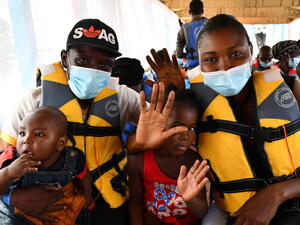First Somali refugees fly home from Kenya after two-year break
First Somali refugees fly home from Kenya after two-year break

Somali refugees boarding the plane for home from Dadaab in eastern Kenya.
DADAAB, Kenya, August 17 (UNHCR) - The first airlifts from Kenya to Somalia in two years left Dadaab this week, bringing dozens of Somali refugees home to the north after more than a decade in exile.
The first group of 43 left Dadaab camp in eastern Kenya for Golkayo in north-central Somalia yesterday, while another group of 16 left today for Bossaso in north-eastern Somalia. All 59 refugees flew on chartered Daallo Airlines flights.
"This is the first repatriation to Somalia to take place from Dadaab in two years since 93 individuals left in 2003," said Toshiro Odashima, who heads UNHCR's office in Dadaab. "We hope more refugees will be encouraged to go back to safe parts of Somalia."
Abdullahi Warsame Ilmi was among this week's returnees. "When I left Somalia, there was war. It was terrible. My wife was shot as we tried to get away," he recalled.
He and his family walked to the Somali capital Mogadishu and then to Liboi, crossing the border into Kenya in 1991. He registered as a refugee in 1994 and lived in Hagadera, one of three camps in Dadaab. Two of his children and one grandchild were born in the camps and know Kenya as home. He is unsure of the conditions back in his homeland, but would rather risk it there than remain in the place he has called home for the past 14 years.
"I was very rich," said Abdullahi. "I owned buildings in Mogadishu. I will not return there though, because I could be killed. I will start afresh in Galkayo. I have family there, they will help me."
Before they left Dadaab, the returning refugees were given an assistance package consisting of basic supplies like plastic sheeting to cover their tukuls (dome-shaped shelters), blankets, cooking sets, sleeping mats and jerry cans. Each family also received an allowance of US$170 for their onward trip to their areas of origin in Somalia and to assist them during the initial reintegration period.
When the plane landed at the Dadaab airstrip, the refugees brought their bags to the plane and began to board, handing in their ration cards, perhaps the last item that identified them as refugees. The children were excited, totally oblivious to the historic moment taking place, shouting and waving "bye-bye" to UNHCR staff on the ground. The adults looked more serious and deep in thought. Some whispered prayers as they took their seats in the plane, while the children played around them. Written on their faces was the anxiety of not knowing what lies ahead and the tremendous responsibility of re-starting their lives, finding homes, jobs, schools and friends.
"Home is home, whether good or bad," said Maryan Omar Maalimahmed, who gave birth to three children in the camp. She left for Galkayo with them, leaving behind her husband and three other children.
"They are in the middle of school, and we do not want to interrupt them," she said. "I am going to stay with my parents, and the rest of the family will join us when they come."
With the installation of a new government and its subsequent return to Somalia, many refugees are hopeful about peace in their country and are now willing to return home. UNHCR only facilitates voluntary return to areas that are peaceful, such as the north-east and north-west.
"Mom! The vehicle is leaving us! Let's go back to Hagadera!" shouted two-year-old Feisal Mohamed Abdi, to the amusement of the refugees leaving for Bossaso earlier today. His mom gently told him that they were not returning to Hagadera camp but were going home to Somalia. A crying Feisal was later coaxed onto the plane by a UNHCR official.
Beside Feisal's family stood a confident-looking man, Adan Mohamed Jama. "I have three wives and lots of children," he said. "But I return home alone today. No family, no belongings. Just me and my brain."
Adan said he was going to assess the situation for himself before allowing his family to travel to Somalia. "Somalia needs me. I am a trained teacher and I am taking my skills for use in my country."
When news hit the airwaves in Somalia about the impending return, Somali residents called in to radio stations to express their joy at having their countrymen return and encouraged more people to go back home.
Registration of more refugees willing to return to peaceful parts of Somalia is ongoing and the next repatriation should take place in the coming months.
As Abdullahi boarded the plane, he was asked, "What if it's not what you expected it to be? Will you come back?" To which he boldly replied, "It was my home for almost 50 years, I will find a way to make it my home again."
More than 157,000 Somali refugees have returned home from Kenya in the last 10 years, 75,000 of them benefiting from assistance and transport provided by UNHCR. Another 146,000 remain in Kenya's Dadaab and Kakuma camps, many of them originating from southern and central Somalia, which are not considered safe for return.
By Janet Adongo and Emmanuel Nyabera
UNHCR Kenya








